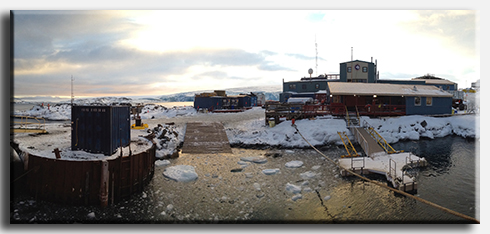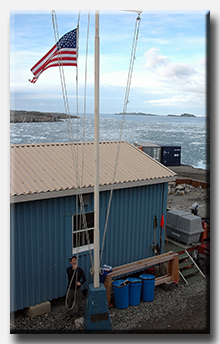Palmer Station
Visit the Palmer Station Station webcam.
Read recent reports from Palmer Station, published in the Antarctic Sun.
Palmer Station is located at 64°46' S, 64°03' W, on a protected harbor on the southwestern coast of Anvers Island off the Antarctica Peninsula. Palmer is the only U.S. Antarctic station north of the Antarctic Circle. The temperature is mild, with monthly averages ranging from minus 10°C in July and August to 2°C in January and February. The annual mean is minus 3°C. The extreme range is minus 31°C to 9°C. It has rained every month at Palmer.
The station, built on solid rock, consists of two major buildings and three small ones, plus two large fuel tanks, a helicopter pad, and a dock. Construction was completed in 1968, replacing a prefabricated wood structure ("Old Palmer," established in 1965) two kilometers away across Arthur Harbor. Old Palmer has been disassembled and removed from Antarctica. Somewhat over 40 people can occupy Palmer in the summer. Wintering population is about 10, although Palmer does not have a long period of winter isolation as do McMurdo and South Pole.

Palmer Station, Anvers Island, Antarctic Peninsula. (NSF photo by Bob DeValentino)
Palmer Station is superbly located for biological studies of birds, seals, and other components of the marine ecosystem. It has a large and extensively equipped laboratory and sea water aquaria. In 1990 it was designated by the National Science Foundation as a long term ecological research (LTER) site. Ocean and climate systems, aeronomy and astrophysics, glaciology, organisms and ecosystems also have been pursued at and around Palmer.

A U.S. Antarctic Program participant raises the U.S. flag at Palmer Station on Anvers Island. (NSF photo by Peter Rejcek)
Palmer Station is named for Nathaniel B. Palmer, a Connecticut sealer who, on 17 November 1820, during an exploratory voyage ranging southward from the South Shetland Islands, may have been the first person to see Antarctica. (British and Russian ships were in the area at about the same time.)
